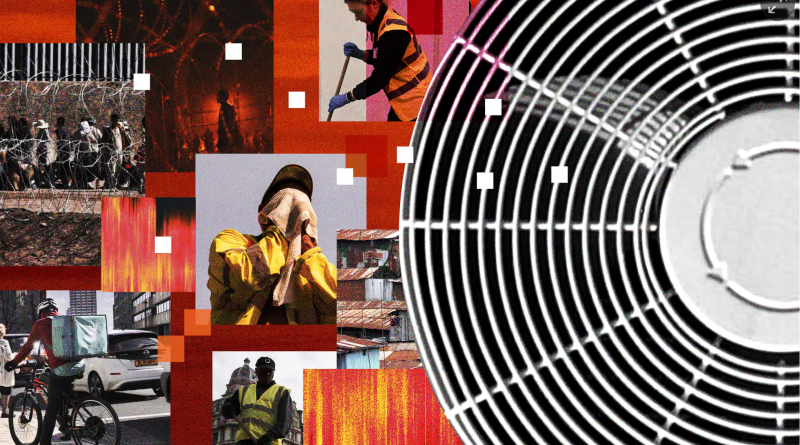Heat inequality ‘causing thousands of unreported deaths in poor countries’

Refugees, cycle couriers, construction workers and street cleaners are among those who suffer with extreme heat. Illustration: Guardian Design
Heat inequality is causing thousands of unreported deaths in poor countries and communities across the world, a leading analyst of climate impacts has warned, following global temperature records that may not have been seen in 120,000 years.
Sweltering conditions act as a stealthy killer that preys on the most economically fragile, said Friederike Otto, co-founder of World Weather Attribution, in an appeal for the media and authorities to pay more attention to the dangers.
“Heatwaves are the deadliest type of extreme weather but they don’t leave a trail of destruction or striking images of devastation. They kill poor, lonely people in rich countries, and poor people working outdoors in developing countries,” said Otto, who is also a senior lecturer in climate science at the Grantham Institute of Imperial College London. “In the last 13 months, there will be thousands and thousands of stories of poor people dying in heat that will never be told.”
The advice comes amid growing concern about the hidden toll of heat inequality. Last month, the UN secretary general announced a call to action on extreme heat, with a focus on care for the vulnerable and protection of exposed workers.
“Extreme heat is increasingly tearing through economies, widening inequalities, undermining the sustainable development goals and killing people. It is estimated to kill almost half a million people a year; that’s about 30 times more than tropical cyclones,” António Guterres pointed out.
This followed the world’s three hottest days on record on 21, 22 and 23 July. As well as passing the previous peak in datasets going back to 1940, climatologists said it was probably also the highest temperature on Earth in about 120,000 years, based on evidence from tree rings and ice cores. It did not come not without warning. Up to July, the Earth had set 13 consecutive monthly temperature records, primarily because of human burning of forests, gas, oil and coal.
A precise death toll from these searing extremes may never be calculated but it is certain that lower income groups will have been worst affected because heat inequality is self-reinforcing. While the rich glide from air-conditioned homes in air-conditioned cars to air-conditioned offices, restaurants and shopping malls, the heat from these artificially cooled environments is sent on to the street outside, where less advantaged workers sweat as couriers, construction workers or road cleaners.
Equality campaigners say the vulnerability gap continues at home. “Deaths from heat are shaped by inequality – a heatwave is far more deadly for someone living in a tin shack than it is for someone in an air-conditioned house,” said Alex Maitland, inequality policy adviser at Oxfam International.
“Over the coming decades, deaths from heat stress are forecast to rise dramatically in low-income countries. The cruel irony is that people who die from heat are the least responsible for soaring temperatures. The richest 1% emit more than two-thirds of the world combined, with their carbon emissions in 2019 alone enough to cause the heat-related deaths of 1.3 million people.”
The inequality of suffering extends to worship and migration. More than 80% of the 1,300 Hajj pilgrims who died of heat-related causes in June were unauthorised pilgrims, who could not afford air-conditioned accommodation and transport and had no access to cooling tents and water stations. Many were staying on the streets in temperatures that approached 50C.
Studies by World Weather Attribution found the heatwave was made up to 2.5C hotter by climate change. “This additional heat would have been the difference between life and death for many of these people,” Otto said.
Asylum seekers, who are often escaping heat and drought, are also at a much higher risk. In June, dozens of Sudanese migrants died from the scorching heat at an illegal border crossing into Egypt. The victims included entire families, said aid groups. Later the same month, the bodies of three Mexican migrants were found in the Sonoran desert in Arizona near the US border as a a brutal heatwave gripped the region. The El Paso Border Patrol sector, which includes parts of Texas and New Mexico, said migrant deaths more than doubled from 2022 to 2023 as a result of the temperature rise.
Last year, the charred bodies of 18 Syrian asylum seekers were found after a wildfire in the Dadia region of north-eastern Greece.
In less developed countries, the authorities often do not have the means to collect data or investigate individual deaths. This is particularly true in conflict regions, such as Afghanistan, Mali, Sudan, Somalia and Central African Republic.
An increasing number of countries are taking action to protect workers from heat by implementing new laws. In Armenia, for example, special breaks should be granted when temperatures go above 40C.
Some countries set different limits depending on how intensive the work is. In Belgium, the limits range between 29C for light physical work and 18C for very heavy work. In Hungary, by comparison, thresholds vary from 27C to 31C. Cyprus, meanwhile, distinguishes between workers who are “acclimatised” to the heat and those who are not; safe working limits for the latter are 2.5C lower.
Dr Halshka Graczyk, a technical specialist on occupational safety and health at the International Labour Organization, said there was evidence of clear productivity loss for every degree rise in temperature.
Although temperature limits at work were increasingly common, they tended to be set in an ad hoc way, she said. “There is no algorithm, there is no way to say your baseline temperature in your country is X and therefore your population is acclimatised to around this temperature.” Nor was there enough monitoring and evaluation to know if the set limits helped protect human health and improve productivity.
Enforcement of these laws is also a continuing tussle. Qatar is one of several Gulf countries that has summertime bans on outdoor work during the hottest times of the day, prohibiting it from 1 June to 15 September between 10am and 3.30pm. However, an investigation by the Independent found hundreds of breaches last year, mostly in the construction industry.
Enforcing indoor limits, such as in factories, could be even harder, given that these workplaces are less visible.
In Indonesia, a lawsuit brought by a group of young people claims, among other things, that insufficient government action on climate crisis is breaching their right to work and earn a decent living. In Bangladesh, a court ordered a nationwide shutdown of schools in April because of a severe heatwave.
Otto urged great global attention on this dimly understood crisis. “We just don’t know how many people are being killed by extreme heat in poor countries. But due to their much higher exposure, there’s no reason to think it’d be a smaller proportion than in rich countries, where we know of the thousands dying,” she said. There is a huge need to report on these dangers, again and again.”
Rather than illustrating heat reports with happy people on the beach, she said the media needed to consider often-hidden and preventable tragedies both in faraway parts of the world and in marginalised communities in their own countries. “To tackle change, we need to create a more equal world, but we also need to tackle inequality at home.”





